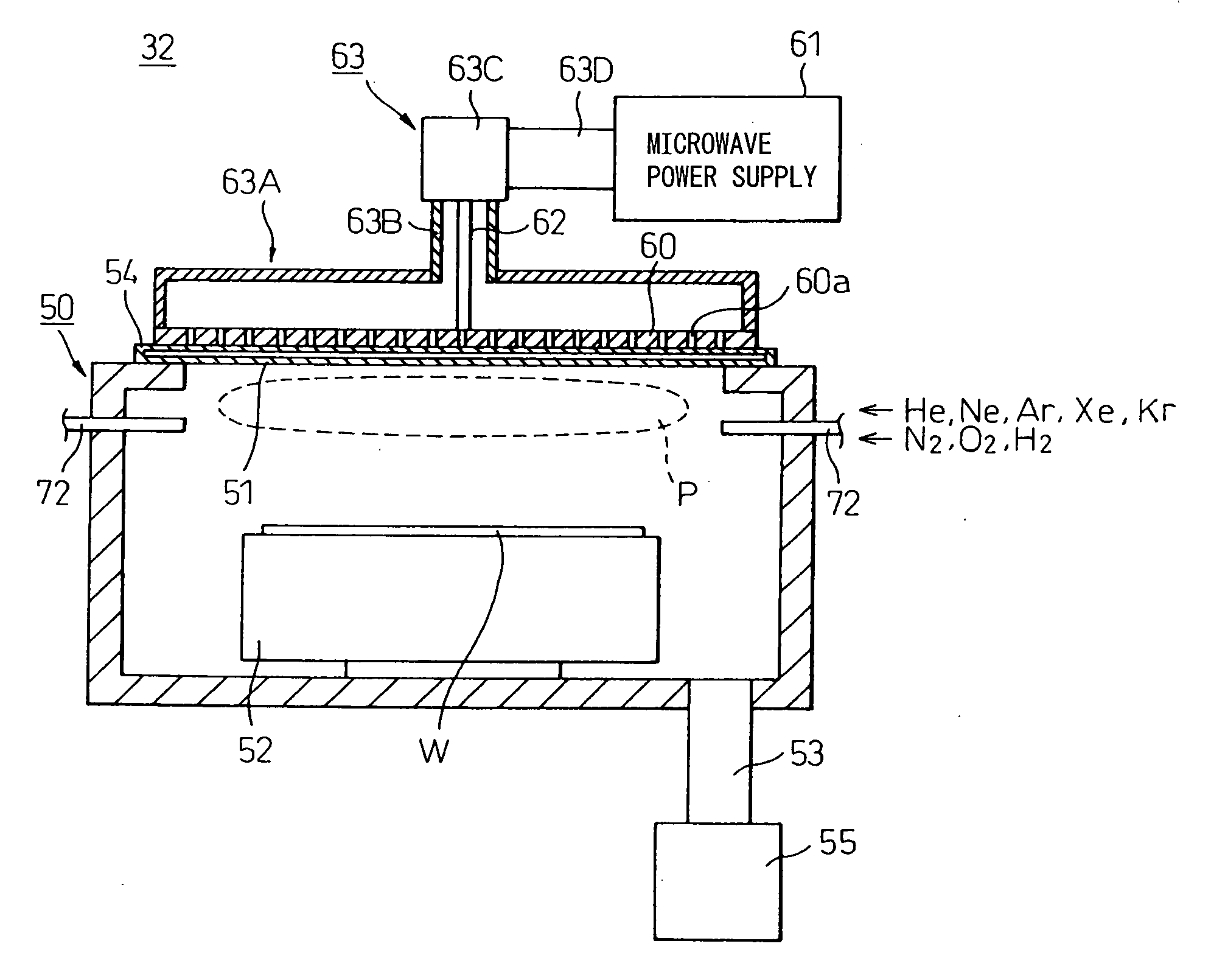Method for forming insulation film
a technology of insulating film and insulating film layer, which is applied in the direction of electrical control, machines/engines, transportation and packaging, etc., can solve the problems of increasing exponentially the leakage current due to a direct tunnel by quantum effect, the thickness reduction of gate insulating film has approached to its limit, and the leakage current can be easily formed, so as to reduce the thickness of the insulating film, the effect of reducing the thickness of the film
- Summary
- Abstract
- Description
- Claims
- Application Information
AI Technical Summary
Benefits of technology
Problems solved by technology
Method used
Image
Examples
embodiment of
(One Embodiment of Production Process)
[0075] A process for forming of the above silicon oxynitride film will be described.
[0076]FIG. 2 is schematic view (schematic plan view) showing an example of the total arrangement of a semiconductor manufacturing equipment 30 for conducting the process for producing an electronic device material according to the present invention.
[0077] As shown in FIG. 2, in a substantially central portion of the semiconductor manufacturing equipment 30, there is disposed a transportation chamber 31 for transporting a wafer W (FIG. 3). Around the transportation chamber 31, there are disposed: plasma processing units 32 and 33 for conducting various treatments on the wafer, two load lock units 34 and 35 for conducting the communication / cutoff between the respective processing chambers, a heating unit 36 for operating various heating treatments, and a heating reaction furnace 47 for conducting various heating treatments on the wafer. These units are disposed s...
embodiment
(Embodiment of Plasma Processing)
[0091] Next, there is described an embodiment of the process processing to be used in the present invention.
[0092] A gate valve (not shown) provided at the side wall of the vacuum container 50 in the plasma processing unit 32 (FIG. 2) is opened, and the above-mentioned wafer W comprising the silicon substrate 1, and the field oxide film 11 formed on the surface of the silicon substrate 1 is placed on the stage 52 (FIG. 3) by means of transportation arms 37 and 38.
[0093] Next, the gate valve was closed so as to seal the inside of the vacuum container 50, and then the inner atmosphere therein is exhausted by the vacuum pump 55 through the exhaust pipe 53 so as to evacuate the vacuum container 50 to a predetermined degree of vacuum and a predetermined pressure in the container 50 is maintained. On the other hand, microwave (e.g., of 1.80 GHz and 2200 W) is generated by the microwave power supply 61, and the microwave is guided by the waveguide so that...
example 1
[0097] A device (N-type MOS capacitor) for carrying out various evaluations was formed by the following method.
[0098] (1): Substrate (FIG. 9)
[0099] As shown in FIG. 9, a P-type silicon substrate having a specific resistance of 8 to 12 Ωcm and plane orientation (100) was used as a substrate. The surface of the silicon substrate had a sacrificial oxide film with a thickness of 500 A (angstrom) previously formed by thermal oxidation.
[0100] (2): Cleaning Before Gate Oxidation
[0101] The sacrificial oxide film and contamination elements (metals and organic matter, particles) were removed by RCA cleaning using a combination of APM (a mixed liquid composed of ammonia, aqueous hydrogen peroxide, and pure water) with HPM (a mixed liquid composed of hydrochloric acid, aqueous hydrogen peroxide, and pure water) and DHF (a mixed liquid composed of hydrofluoric acid and pure water).
[0102] (3): Plasma Treatment Before Oxidation (FIG. 10)
[0103] After the treatment in the above step (2), RLSA ...
PUM
| Property | Measurement | Unit |
|---|---|---|
| thickness | aaaaa | aaaaa |
| gate voltage | aaaaa | aaaaa |
| temperature | aaaaa | aaaaa |
Abstract
Description
Claims
Application Information
 Login to View More
Login to View More - R&D
- Intellectual Property
- Life Sciences
- Materials
- Tech Scout
- Unparalleled Data Quality
- Higher Quality Content
- 60% Fewer Hallucinations
Browse by: Latest US Patents, China's latest patents, Technical Efficacy Thesaurus, Application Domain, Technology Topic, Popular Technical Reports.
© 2025 PatSnap. All rights reserved.Legal|Privacy policy|Modern Slavery Act Transparency Statement|Sitemap|About US| Contact US: help@patsnap.com



